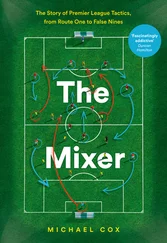‘Koeman was one of the first central defenders with the quality not just to defend,’ said Guardiola, who Koeman took under his wing at Barca. ‘I think Johan Cruyff bought Ronald Koeman to show us, to teach us, why we need a central defender like Ronald … most of the quality was his build-up, amazing long balls, forty metres, quick balls. He is one of the best central defenders I’ve ever seen in my life.’ Koeman’s regular forward charges rarely exposed Barcelona in a defensive sense because they could rely on Guardiola’s selfless, intelligent play in the holding midfield position. This was particularly crucial when Cruyff played the 3–4–3, with Koeman the centre-back and Guardiola the holding midfielder. Guardiola, often wearing number 3 at this stage, would effectively become Barcelona’s main defender, covering for his attack-minded teammate in the original manner of Total Football.
While Guardiola is widely considered a deep midfielder, Cruyff often referred to him as a defender. ‘As a player he was tactically perfect but he said he couldn’t defend,’ said Cruyff. ‘I said: “I agree – in a limited way. You’re a bad defender if you have to cover this whole area. But if you have to defend this one small area, then you’re the best. Make sure that there are people to cover the other areas. As long as you do that, you can be a very good defender.” And he did become very good.’ Cruyff sometimes deployed Guardiola as a conventional centre-back; in late 1991 Cruyff even handed him the job of man-marking Real Madrid’s outstanding striker Emilio Butragueño, the reigning Pichichi. Perhaps the most significant example came in a 2–2 UEFA Cup draw away at Bayern Munich in April 1996; the idea of Guardiola, a midfielder, being deployed in defence would prove particularly prescient considering his own use of Javier Mascherano and Javi Martínez when later coaching these two clubs.
Cruyff insisted that Koeman and Guardiola, two players he praised primarily for their passing, were a perfectly functional pairing because of their positional strength and intelligence. ‘As the central defensive duo, they weren’t fast and they weren’t defenders,’ Cruyff admitted. But he believed there were only three passes that Barca needed to worry about: balls over the top would be intercepted by his goalkeeper, the aggressive Busquets; crossfield balls would be dealt with by his speedy full-backs Albert Ferrer and Sergi Barjuán, academy products and converted wingers; balls down the centre, meanwhile, wouldn’t be a problem because Cruyff was confident Koeman and Guardiola communicated well, and were flawless in a positional sense. Sometimes he referred to the duo as both ‘midfielder-defenders’, which summarised the Dutch interpretation of defenders – they aren’t really defenders at all.
Transition: Netherlands–Italy
Juventus required a penalty shoot-out to confirm their triumph over Ajax in the 1996 Champions League Final, but this nevertheless felt like a turning point in European football, the moment when Dutch dominance gave way to Italian ascendency. Ajax, the previous season’s Champions League winners, found themselves unable to cope with the speed and power of Juve’s forwards, and the Italian side should have killed the game before half-time.
For Ajax, the problem wasn’t simply defeat and the failure to retain their trophy, but the knowledge it was the end of an era. Midway through 1995/96 European football had been shaken by the Bosman ruling, which had two major impacts. First, players could run down their contracts and transfer elsewhere for free. Second, the three-foreigner rule was now illegal, and European clubs could field as many EU nationals as they liked.
No club suffered as much as Ajax. At the end of 1995/96 Edgar Davids, arguably Europe’s most coveted midfielder, left for AC Milan on a free transfer – previously, Ajax would have received a fee and reinvested the proceeds. Meanwhile, the liberalisation of the rules regarding the number of foreign players permitted meant there was now extra overseas demand for Ajax’s other stars, and within three years they found almost their entire Champions League-winning side had departed. Davids, Winston Bogarde, Edwin van der Sar, Michael Reiziger, Nwankwo Kanu and Patrick Kluivert all headed to Serie A, mirroring the shift in power. Bosman had made players, and Europe’s major leagues, considerably more powerful, and Ajax were no longer among Europe’s elite.
1996 also saw Ajax depart their much-loved De Meer Stadion, moving to the Amsterdam Arena – later renamed the Johan Cruyff Arena – in the south of the city. They encountered serious problems with the new stadium, which wasn’t simply a football ground, but a multipurpose arena also used for concerts. Grass didn’t grow properly, which hampered Ajax’s passing football, and to many supporters it just didn’t feel like home. Louis van Gaal initially intended to leave in 1996, but stuck around one more year for personal reasons. Cruyff, meanwhile, left Barcelona in 1996 and would never coach again, while Holland were hugely disappointing at Euro 96, thrashed 4–1 in the group stage by England, and exiting after a quarter-final penalty shoot-out defeat to France. Holland’s customary tournament arguments seemed particularly serious, too, with various suggestions of a divide between black and white players.
With Dutch football’s reputation taking a battering, then, Italy became the centre of European football. Serie A had been Europe’s strongest league throughout the 1990s, evidenced by their clubs’ dominance of the European competitions, but only now, with the sexier, more forward-thinking Ajax out of the picture, was its superiority unquestionable.
Whereas Ajax focused on youth development, Italian clubs depended on financial clout. The country’s major clubs were owned by absurdly wealthy businessmen – at least in theory, as many later found themselves financially ruined – who competed to sign the world’s greatest talents. The so-called ‘seven sisters’ of Italian football had emerged: Juventus, Milan, Inter, Roma, Lazio, Parma and Fiorentina all boasted world-class players, and all seven started each season with a genuine chance of glory. In terms of overall strength and competitiveness, there has probably never been a better league than Serie A during the mid- to late-1990s.
Stylistically, Serie A was in a peculiar place. Italian football had always been considered defensive, with its infamous catenaccio of the 1960s still influencing tactical thought. While the attack-minded Milan boss Arrigo Sacchi had revolutionised football in the late 1980s by overhauling catenaccio and introducing the pressing game, he’d been inspired by Ajax’s Total Football, and his approach was atypical for an Italian coach.
During this period Italian football’s major tactical themes were essentially debates between coaches who were pro-Sacchi and those who were Italian traditionalists. Sacchi promoted a proactive style of football in an inflexible 4–4–2 system, which featured no trequartista (the number 10) or libero (the sweeper). But, by nature, Italian coaches adapted their system to the opposition’s approach, most loved their trequartisti and many still insisted on a libero . Italian football during this era was not about following Sacchi’s Dutch-centric ideals, but about returning Serie A to the old Italian way.
Part Two
In the closing stages of Juventus’s 1996 Champions League Final victory over Ajax, there was an unusual incident that summed up so much about Juventus, and so much about Italian football.
Ajax, in keeping with their customary approach, constantly switched play in the first half between right-winger Finidi George and left-winger Kiki Musampa. Juve’s aggressive 4–3–3 system, featuring three outright forwards in Alessandro Del Piero, Gianluca Vialli and Fabrizio Ravanelli, meant that neither of Juventus’s most impressive performers on the night, the unheralded full-back pairing of Gianluca Pessotto and Moreno Torricelli, were afforded protection against Ajax’s wingers, but both defenders were magnificent, sticking tight and refusing to let the Ajax wingers turn. Pessotto completely nullified Finidi, while Torricelli intercepted passes and launched quick counter-attacks. Louis van Gaal evidently decided that Ajax weren’t likely to get the better of Torricelli, and at half-time he removed Musampa. Ronald de Boer, who had started in central midfield, moved to the left.
Читать дальше












